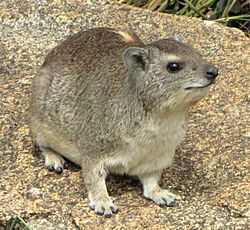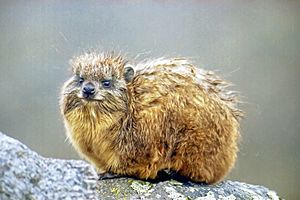Hyrax facts for kids
Quick facts for kids HyraxesTemporal range: Early Eocene - Recent
|
|
|---|---|
 |
|
| Yellow-spotted Hyrax (Heterohyrax brucei) | |
| Scientific classification | |
| Kingdom: | |
| Phylum: | |
| Class: | |
| Superorder: | |
| Order: |
Hyracoidea
Huxley, 1869
|
| Genera | |
Procavia |
|
Hyraxes, also known as dassies, are small, furry mammals. There are four main types of hyraxes. They live in Africa and parts of southwestern Asia.
These animals are round and furry with short tails. Most hyraxes are about 30 to 70 centimeters long. They usually weigh between 2 and 5 kilograms. Hyraxes are even mentioned in old texts like the Bible! Some people think the name for present-day Spain might come from an old Hebrew word for hyrax. This is because early explorers might have mistaken rabbits in Spain for a type of hyrax.
Contents
What Makes Hyraxes Special?

Hyraxes have some unique features. They are not very good at keeping their body temperature steady on their own. So, they often huddle together or sunbathe to warm up. This is called thermoregulation.
Unlike many other plant-eating animals, hyraxes do not use their front teeth to cut leaves or grass. Instead, they use their back teeth, called molars. Their two upper front teeth are large and grow continuously, a bit like a rodent's teeth. Their four lower front teeth look like a comb.
Hyraxes have complex stomachs with many chambers. This helps special bacteria break down tough plant material. Even though their chewing looks like they are chewing cud, like cows, they cannot actually bring food back up to chew it again. This chewing behavior might also be a way they show they feel threatened.
Where Hyraxes Live
Hyraxes live in rocky areas across sub-Saharan Africa and the Middle East. Their feet have rubbery pads with many sweat glands. These pads help them grip and move quickly up steep, rocky surfaces. Hyraxes have short toes with hoof-like nails. They have four toes on each front foot and three on each back foot. They also have very efficient kidneys. This helps them save water, which is important for living in dry places.
Hyrax Reproduction and Family Life
Female hyraxes usually give birth to up to four young at a time. The babies are born after about seven to eight months. Young hyraxes drink their mother's milk for one to five months. They become old enough to have their own babies when they are about 16 to 17 months old.
Hyraxes live in small family groups. One male hyrax will fiercely protect his territory from other males. If there is a lot of space, one male might have access to several groups of females. Other males often live alone, usually near the edges of areas controlled by larger males. These solitary males might only mate with younger females.
Images for kids
-
Pachyhyrax championi, a large fossil hyrax from the Miocene of Rusinga, Kenya (Natural History Museum collection)
See also
 In Spanish: Hiracoideos para niños
In Spanish: Hiracoideos para niños


